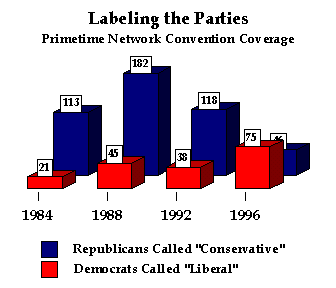Four Campaigns, Eight Conventions...But Just One Spin
Table of Contents:
- Four Campaigns, Eight Conventions...But Just One Spin
- Introduction
- Questions: Leftward, Ho!
- Labeling: Republican Extremists vs. Democratic Moderates
- Controversies: Separate and Unequal Treatment
- Conclusion: Recommendations for Fair and Balanced Coverage
Labeling: Republican Extremists vs. Democratic Moderates
As a general campaign strategy, both political parties covet the label "moderate" — it’s seen as validation of a party’s normalcy and it greatly aids efforts to paint the opposition as extremist weirdos. Yet over the last four cycles, network reporters have helped label the Democratic Party — whether headed by Bill Clinton, Michael Dukakis or Walter Mondale — as moderate, while the Republican Party was invariably branded as an ideological party, regardless of whether the nominee was Ronald Reagan, George Bush, or Bob Dole.

The disparity in the spin caught by Bill Adams back in 1984 is the most remarkable, if only because the San Francisco convention is now widely regarded (even by reporters) as having been far too liberal for most Americans. But back then, Adams wrote, "both CBS News and NBC News portrayed the Mondale-Ferraro approach as a move to the moderate middle: Dan Rather said Mondale wanted the party back in ‘the middle of the road,’ and he described the Democratic Party’s aim for a ‘centrist approach’ and ‘a rush to the middle.’ He also called Ferraro’s speech ‘pretty conservative.’"
"Together," Adams reported, "both CBS News and NBC News called the Republican party, its platform, or its dominant leaders by conservative labels 113 times. They called the Democrats by liberal labels 21 times and moderate labels 14 times."
In 1988, the MRC detected a similar pattern in ABC’s, CBS’s, CNN’s and NBC’s coverage. In a total of just under 50 hours of prime time coverage of the Atlanta convention, Governor Dukakis was called a "liberal" or a "progressive" just 13 times, or about once every 3.8 hours. Republicans were called conservative 182 times, four times as frequently as the Democrats were labeled at their convention.
CNN’s Mary Tillotson told viewers she smelled a "conservative odor" in the New Orleans’ Superdome where that year’s GOP convention was held.
In Houston in 1992, Republicans were described with various conservative labels over moderate ones by a margin of 9-to-1. In total, viewers heard 118 conservative labels, compared with 13 moderate ones. On the fourth night of the convention, for example, Connie Chung, then with CBS, provocatively asked Pat Robertson, "Has the party gone far right enough for you? I mean, there’s gay bashing that you brought up. There’s some people who think it’s gone too far."
That year, the Democrats were more frequently called "moderate" or "conservative" than they were "liberal." The Clinton-Gore ticket and the Democratic platform were never called liberal, only "moderate," "centrist" or "conservative." Tom Brokaw told viewers on the second night that "this party and its platform have moved to the center since the 1988 campaign." Of course, NBC helped portray the Democrats as centrists back in 1988.
Given this track record, an unusual thing happened in 1996: Democrats were labeled by network reporters as "liberal" more often than Republicans were described as "conservative." The overall coverage promoted the idea that the Clinton administration was filled with centrists who had captured the Democratic Party, a concept that reporters chose to illustrate by labeling individual delegates or officeholders, as when NBC’s Gwen Ifill introduced Rep. Barney Frank as "an outspoken liberal, one of the last few standing." But, compared with earlier conventions, the coverage notably acknowledged that the Democratic Party is home to ideologues.
Yet even in 1996, reporters were four times as likely to use "extreme" language (such as "far right" or "hard right") to label Republican candidates, speakers, delegates or the platform, compared with their Democratic counterparts. That’s still better than in 1992, when the difference in the two parties was incalculable: Republicans were tagged as extremists 10 times, while Democrats were never so labeled.
In summary, regardless of their nominee’s views, Democrats were more likely than Republicans to be portrayed as "moderates," while Republicans were nearly three times as likely to be portrayed as ideological (459 conservative labels, vs. 179 liberal labels for the Democrats).


